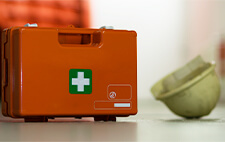How Workplace Safety Measures Can Save You Money

Accidents happen, it’s a fact of life. But one of the most frustrating and upsetting things for an employee to go through is being injured in a preventable accident. There were 71,062 non-fatal injuries to UK workers between 2017/18, which in turn, caused UK workplaces to lose a total of 3.9 million working days. This is a problem for both employees and employers in the long run.
The cost of workplace injuries is substantial too. In 2016/17 the total came to £5.2 billion — this cost includes all the financial aspects of a workplace injury, including lost working hours and any pay-outs for accident at work claims made. .
Ensuring you have the correct equipment
Having the correct equipment on hand can make all the difference. In 2017/18, the construction industry suffered the most fatalities from work accidents, with 38 deaths. Agriculture had 29 deaths, and manufacturing suffered 15 fatalities. These industries in particular often require certain safety equipment to abide by health and safety regulations – and wearing the equipment could separate your employees from a near death experience and a non-fatal injury.
One example is that, naturally, a hard helmet on a construction site helps to reduce the risk of head injuries. If your staff fail to wear the required hard hat, any of those injuries could be a direct cause of not wearing the correct safety equipment. Protective glasses should also be worn by employees that are exposed to debris, dust and bright lights that could damage the employee’s sight.
Of course, there are other items of protective clothing too. These include steel toe cap boots, hi-vis clothing, safety gloves and noise cancelling headphones. Implementing a work policy that says your staff are required to wear safety clothing and equipment is the first step to preventing workplace injuries that could lead to fatal deaths or long-term work absences, which cost your company money.
Training
Correct training is vital in the role of risk reduction. Every employee should be briefed on the safest fire exits around the premises, as well as what the procedure is in case of an emergency. In fact, many premises are permitted to carry out practice fire drills to ensure all members of staff are aware of the routine.
It does, of course, extend beyond fire safety training. In the manufacturing industry, which is the third most dangerous environment for fatal injuries in the workplace, some job roles require particular training and qualifications to use machinery. Where hazardous or dangerous machinery is involved, staff must be trained on how to use it – and must use the correct safety equipment and clothing at all times. 135,000 of the 555,000 non-fatal injuries in 2017/18 led to over 7 days of work absence — providing your staff with the appropriate training could save you a big cost seen through a loss of working hours due to workplace injuries.
Individual roles may need specific training too. Some processes will need employees to gain the correct certification to be able to carry them out with reduced risk of injury and know fall protection options. For example, in the construction industry, any employee who will be navigating a crane will require a Construction Plant Competency Scheme (CPCS) licence.
Additional training
The best way to identify risks is to perform regular internal audits. For example, slips, trips and falls caused 31% of non-fatal injuries in the workplace in 2017/18. The main causes of slips, trips and falls in the workplace are uneven floor surfaces, unsuitable floor coverings, wet floors, changes in levels, trailing cables and poor lighting – all of which can be prevented or marked out safely if the proper regulations are followed. Legally, businesses must follow The Workplace (Health, Safety and Welfare) Regulations 1992, which stipulates that employers must ensure that floor spaces are in good condition and free from obstructions. Furthermore, the Health and Safety (Safety Signs and Signals) Regulations 1996 legally require businesses to provide and display the appropriate safety signs when there is a potential risk too – whether that is a wet floor sign, or signs indicating loose cables or exposed electric cables.
These safety measures are designed to protect everyone and everything within a business. Take a look through your current processes regularly to ensure they are still performing correctly.








